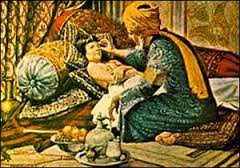[Compiled
by: Kandiah Thillaivinayagalingam]-
Devotional Statues
A devotional statue dating to
2600 B.C. of what scholars believe is a married couple. The gypsum statue was
found buried beneath the floor of a shrine at Nippur in Iraq and mesures 3.5
inches wide at the bottom. The couple originally had feet, and the figures have
eyes made of shell and lapis lazuli set in bitumen, a natural cement-like
substance.The statues are usually carved with the hands clasped, right over
left, at the chest or waist in a gesture of attentiveness.and were placed in
temples to show an adherent’s devotion to their gods.These statues have
impacted our lives today because we still worship God or God's. Also, we still
all have religions and beliefs.
Games
A Sumerian game board and
playing pieces made of shell, bone, lapis lazuli, and red limestone. They were
found in the Royal Cemetery at Ur in Iraq by Sir Leonard Woolley in the 1920s
and date to the twenty-fifth century B.C.The game board measures about 10.5
inches long and 4.5 inches wide.The rules of the game as it was played around
2500BC are not know at all but the same boards were still in use a century or
two before the birth of Christ and archeologists have discovered the rules for
the game played at that time on some cuneiform tablet dated at 177/176BC. Here
the number of players are 2 & Aim of the game to be the first to get all
the counters around the board to the finish point.The players plays
alternatively & The travels of counters are made following the throw of the
dices.The path of the counters is illustrated above.The counters are allowed to
jump over each others. If one falls on the same square that one counter of the
opponent, it is send off the board and must start again from the beginning.The
squares with a rosette allow the player to throw the dices again .
Irrigation
An irrigated field on the
banks of the Euphrates River in Iraq. The irrigation canal connects to the
river, which can be seen in the background.Because of the fertile soil provided
by the Tigris and Euphrates Rivers, the region had plenty of food to feed the
people who lived there. This allowed the people to stop spending the majority
of their time searching for food. They now had more time to spend creating a
civilization.Once people could control the production of food and be assured of
a reliable annual supply of it, their lives changed completely. Being settled
in one place made it possible to domesticate animals in order to provide other
sources of food and clothing.With more food available, more people could be
fed. Populations therefore increased. The growing number of people available
for more kinds of work led to the development of more complex social
structures. With a food surplus, a community could support a variety of workers
who were not farmers such as ensis,the ruler
of the City-states,as well as
priests, artists, craftsmen, and others.As villages grew, the accumulation of
more numerous and substantial goods became possible. Heavier pottery replaced
animal-skin gourds as containers for food and liquids. Cloth could be woven
from wool and flax. Permanent structures made of wood, brick, and stone could
be erected.People studied the movements of the moon, sun, and planets to
calculate seasons. In so doing they created the first calendars. With a
calendar it was possible to calculate the arrival of each growing season.
Measurement of land areas was necessary if property was to be divided
accurately. Measurements of amounts--for example, of seeds or grains--was also
a factor in farming and housekeeping. Later came measures of value as commodity
and money exchange became common.In this way,this Sumerian civilization was
finally become responsible for many of first achievements.
Mathematics
Two fragments of an ancient
Mesopotamian clay tablet containing geometry exercises and questions written in
cuneiform. From 2600 BC onwards, the Sumerians wrote multiplication tables on
clay tablets and dealt with geometrical exercises and division problems.Also
Tessellations were used by the Sumerians (about 4000 BC) in building wall
decorations formed by patterns of clay tiles.
Medicine
An ancient Mesopotamian skull with
three holes cut in it. Such holes are the result of a surgical procedure
performed by ancient Sumerian doctors. This individual is believed to have
survived the surgery, since the bone shows signs of healing.Also by examining
the surviving medical tablets it is clear that there were two distinct types of
professional medical practitioners in ancient Mesopotamia. The first type of
practitioner was the ashipu,often called as a "sorcerer.",who determined which god or spirits or ghosts was
causing the illness. The
ashipu also attempted to determine if the disease was the result of some error
or sin on the part of the patient and attempt to cure the patient by means of
charms and spells that were designed to entice away or drive out the spirit
causing the disease.The second type was the asu. He was a specialist in herbal
remedies,who was frequently called "physician" because he dealt in
what were often classifiable as empirical applications of medication. For
example, when treating wounds the asu generally relied on three fundamental
techniques: washing, bandaging, and making plasters. All three of these
techniques of the asu appear in the world's oldest known medical document (
2100 BC).:
PART::46 WILL
FOLLOW IN NEXT WEEK





No comments:
Post a Comment